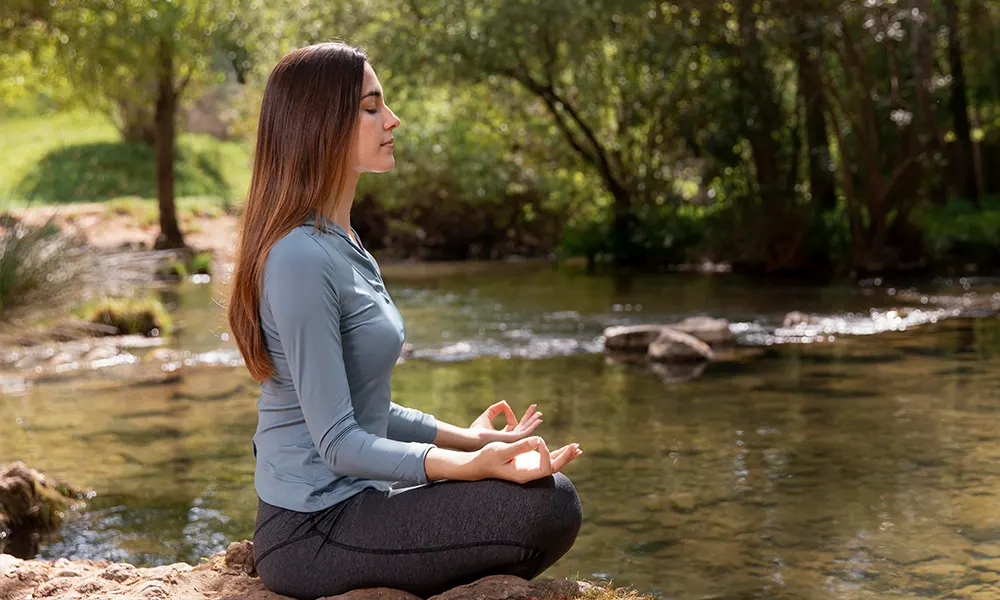Meditation can brush away your day’s stress and can bring inner peace. Now, let us see how you can learn to practice meditation whenever you need it most.
If stress has made you anxious, tense, and worried, you can try meditation. Practicing meditation every day for a few minutes can help restore your calm and inner peace. Moreover, anyone can practice meditation as it is simple, inexpensive, and does not require any exceptional pieces of equipment.
Furthermore, you can practice meditation anywhere and anytime – whether you are out for a walk, riding the bus, waiting at the doctor’s office, or even in the middle of something else.
Understanding Meditation
People have been practicing meditation for thousands of years to keep themselves fit and fine. Meditation is a way to strengthen our relationship with God and deepen our understanding of the sacred and mystical forces. Moreover, meditation is a practice commonly used for relaxation and stress reduction.
In other words, meditation is a medication for the well-being of the mind, and it works as complementary medicine. Additionally, meditation can build a deep state of relaxation and a peaceful mind.
While practicing meditation, you should concentrate in between your eyes (third eye) and try to keep your mind relaxed by eliminating all sorts of thoughts from it so that you can connect yourself with the supreme power. Moreover, this process can help you with enhanced physical and emotional well-being.
Benefits of Meditation
Undoubtedly, meditation gives you a sense of peacefulness, harmony, and a balanced state of mind that can help you with emotional and physical well-being. Additionally, meditation can help you stay relaxed and cope with stressful situations by refocusing your attention on something calming. Moreover, meditation can help you learn to stay centered and maintain inner peace.
Furthermore, the benefits of practicing meditation do not end with the end of your meditation session, but it keeps you calm throughout the day. Moreover, meditation can help you manage symptoms of some medical conditions.
Meditation – Emotional and Physical Well-Being
Meditation helps clear the negative information stored in your mind that leads you to stress. Moreover, the following are some of the emotional and physical benefits of performing meditation:
- Gaining A New Viewpoint On Stressful Situations
- Building Skills To Handle Your Stress
- Augmenting Self-awareness
- Concentrating On The Present
- Relieving Negative Emotions
- Improving Imagination And Creativity
- Boosting Patience And Tolerance
- Reducing Resting Heart Rate
- Reducing Resting Blood Pressure
- Enhancing Sleep Quality
Meditation Removes Illness
If you are dealing with any medical condition, including meditation in your routine can help reduce the symptoms and height of the severity of the disease. Moreover, meditation can help you treat the following health conditions:
- Anxiety
- Asthma
- Cancer
- Chronic Pain
- Depression
- Heart Disease
- High Blood Pressure
- Irritable Bowel Syndrome
- Sleep Problems
- Tension Headaches
Types of Meditation
Meditation is an umbrella term for the treatment of many health conditions and a panacea to achieving a relaxed state of mind. Moreover, there are many kinds of meditation and relaxation techniques that have meditation components. All convey the exact purpose of attaining inner peace.
Guided Meditation
As the name indicates, guided meditation enables you to be coached by someone else. A guide may assist you in drumming up specific mental imagery, or they may walk you through a series of breathing exercises or mantras to support your meditation practice.
The guide will teach you to relax specific muscles in the body until they are comfortable and will then lead you through mental images and visualizations, often of healing light or the dissipation of past wrongs. Guided meditation can be of any duration of your choice.
Mantra Meditation
Mantra is a Sanskrit term, with “man” meaning “mind” and “tra” meaning “release.” Think of a mantra — a word or phrase you repeat during meditation — as a tool to help release your mind. Moreover, in this type of meditation, you repeat a calming word, thought, or phrase to prevent distracting thoughts.
Mindfulness Meditation
This type of meditation is based on being mindful or having an improved understanding and endorsement of living in the present moment. In mindfulness meditation, you enlarge your conscious attention. Additionally, you concentrate on what you experience during meditation, such as the flow of your breath. Moreover, you can monitor your thoughts and emotions but let them pass without judgment.
Yoga
Yoga works on one’s body, mind, emotion, and energy level. It has given height to four vast classifications of Yoga: Karma Yoga, where we use the body; Bhakti Yoga, where we use the emotions; Gyana yoga, where we use the mind and intellect; and Kriya Yoga, where we use the energy.
Yoga is a spiritual practice based on an incredibly subtle science that concentrates on bringing harmony between mind and body. Moreover, it is an art and science of healthy living. Furthermore, slow movements and deep breathing improve blood flow, and warm-up muscles while holding a pose can build strength.
Elements of Meditation
As you know, there are different types of meditation, and these types may include various features to help you meditate. Additionally, it may depend upon the guidance you follow. Moreover, the following are some of the main characteristics of meditation:
Focused Attention
Yoga is all about attention and concentration. Moreover, there is nothing wrong with saying that ‘focus’ is one of the most essential elements of meditation. In other words, concentrating between your eyes to establish a firm connection with the supreme power is known as yoga.
Also, it helps keep your mind free from distractions that cause stress and worry. Furthermore, you can concentrate on a specific object, an image, a mantra, or even your breathing to keep your mind free from distractions.
Relaxed Breathing
This technique includes deep, even-paced breathing techniques by making diaphragm muscles in use to expand your lungs. Additionally, the purpose is to slow your breathing rate, intake more oxygen, and reduce the use of the shoulder, neck, and upper chest muscles while breathing.
A Quiet Setting
If you are a beginner or new to meditation, practicing meditation may be easy for you. Moreover, it would be great to meditate in a place free from media devices, such as television, radios, cellphones, or any other media device. On the other hand, if you practice daily, you can perform meditation in any silent place. Apart from this, it would be great to meditate in a stressful situation to keep your mind free from negativity.
A Comfortable Position
If you are skilled in meditation, you can practice meditation whether you are sitting, lying down, walking, in other positions, or while performing any activity. Moreover, the main goal is to be comfortable so that you can acquire the most out of your meditation.
Final Words
We hope you found the article interesting and informative. In this guide, we learned about meditation, its types, elements, benefits, and the health conditions that can be cured by practicing meditation. Therefore, if you find it interesting and want to get rid of stress, anxiety, and daily life frustration, starting your day with meditation can help you live your life to the maximum.




